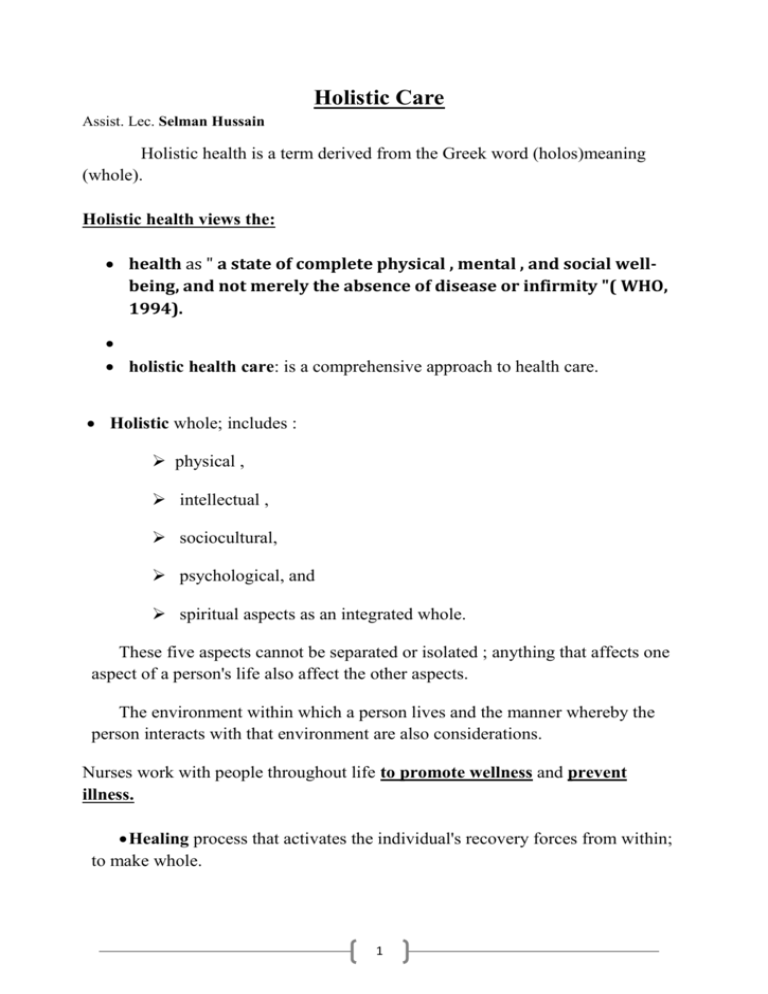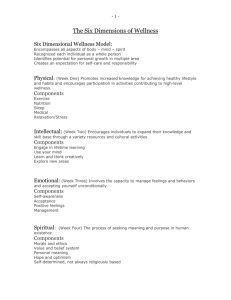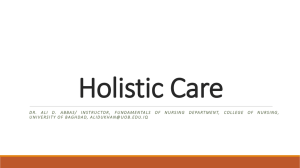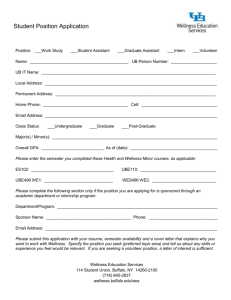Holistic Care
advertisement

Holistic Care Assist. Lec. Selman Hussain Holistic health is a term derived from the Greek word (holos)meaning (whole). Holistic health views the: health as " a state of complete physical , mental , and social wellbeing, and not merely the absence of disease or infirmity "( WHO, 1994). holistic health care: is a comprehensive approach to health care. Holistic whole; includes : physical , intellectual , sociocultural, psychological, and spiritual aspects as an integrated whole. These five aspects cannot be separated or isolated ; anything that affects one aspect of a person's life also affect the other aspects. The environment within which a person lives and the manner whereby the person interacts with that environment are also considerations. Nurses work with people throughout life to promote wellness and prevent illness. Healing process that activates the individual's recovery forces from within; to make whole. 1 Healing is often different from curing. Although curing is a disease may or may not be possible, While, Healing is always possible. Homeostasis balance or equilibrium among the physiologic , psychological, sociocultural , intellectual, and spiritual needs of the body; maintenance of internal environment. The goal of holistic nursing is the " enhancement of healing the whole person from birth to death". Wellness Wellness includes physical, intellectual, sociocultural, psychological, and spiritual health Wellness is aspect of a person s life as an integrated Wellness: is a responsibility, choice, a lifestyle design that helps maintain that highest potential for personal health. Wellness state of optimal health wherein an individual maximizes human potential, moves toward integration of human functioning , has greater selfawareness and self-satisfaction, and takes responsibility for health. Health continuum is a way to visualize the range of an individual's health , from highest health potential to death. a person at the highest level of wellness is one who demonstrate good physical self-care, emotional well-being, creative expression, and positive relationships with others. death critical Illness illness Or poor Health mild Illness normal Health Health continuum 2 good Health Highest health Potential Maslow’s Hierarchy of Needs Abraham Maslow developed a theory of behavioral motivation based on needs. SelfActualization self-steam Love & Belonging Needs Safety and Security Needs Physiological Needs Maslow’s Hierarchy of Needs theory of behavioral motivation based on needs; includes physiologic, safety and security, love and belonging, self-steam, and self-actualization need. Levels of hierarchy: 1- physiological needs. (needs of oxygen, water, food, elimination, rest(sleep)/ activity(exercise), and sex. 2- Safety and security needs. safety needs include both physical and emotional aspect such as ( health, employment, safety, security, family) Illness is often a threat to safety because the stability of life is disrupted. 3- love and Belonging needs. Include ( love, affection, intimacy, acceptance, family, friendship) Having friends and participating with others in groups and organizations are two ways to meet these needs. Meeting these needs is extremely important for mental health. 4- Self-Esteem needs. that include (confidence, respect, status, recognition, competence, freedom). self-esteem met by achieving success in work and other activities. 3 5- Self-Actualization needs.(is the highest level of the Maslow hierarchy) Potential, acceptance, morality, understanding, creativity, inner peace Maslow contends that because most people are so busy meeting the physiological and safety and security needs, Little time or energy is left to meet the love and belonging, self-esteem, and self-actualization needs. Most people are less than satisfied at higher levels of the hierarchy. Providing quality care: 1- first step in providing quality client care is to be aware of yourself. 2- the next step is taking care of your own needs. Self-Awareness: is consciously knowing how the self thinks, feel, believes, and behaves at any specific time. Self-awareness is extremely important for nurses. Nurses must understand themselves so that their personal feelings, attitudes, and needs do not interfere with providing quality client care. All decisions about client care must be made in response to the client's needs, not the nurse's needs. Development of self-concept: Self-concept is how a person thinks or feels about himself, these come from the experiences the person has with others and reflect how the person thinks others view him. Self-concept begins forming in infancy Experiences both positive and negative, influence a person's self-concept. Interactions with significant others, such as parents, extended family, and friends, have great impact on self-concept. Self-concept develops through feedback from others. The nurse is responsible for providing feedback that will not negatively affect the clients self-concept. 4 Self-Care as a prerequisite to client care: The nurse helping clients how to recognize their own action can prevent many of the conditions that cause illness. Exp: choosing exercise regularly, to eat balanced diet, to eat breakfast each day, to control fat content, and to select from basic food groups are good rules for wellness, and choosing to not smoke, can help prevent many of the condition that cause disease and death. The nurse emphasizing health promotion and client education. The nurse is not enough to tell a client what can be done to improve health, the nurse must also be prepared to explain why. Components of self-awareness for a person A. Physical wellness: refer to a healthy body functions at an optimal level. How to achieve physical wellness 1. Grooming: the nurse communicates a message of health and wellbeing by being clean and neatly dressed ( daily bath, use deodorant form, hair clean, regular dental checkups, mouth care, dry skin, nail not harbor dirt, jewelry can harbor bacteria). 2. Body Mechanics: using the body in the safest and most efficient way to move or lift objects. 3. Posture: good posture means the ability to carry oneself well and in correct body alignment. - posture can also send messages about a person 4. Smoking: smoking contributes to many health hazards and illness. - the Oder of smoke, on clothes or breath may participate allergic reaction or lead felling of nausea in some clients. 5. Drugs and Alcohol: drug abuse has become so widespread within the health professions. - A nurse should never give or make a drug available to anyone without written order of physician. 6. Nutrition: nurses must be able to think clearly and work efficiently - A balance diets, includes fruits, vegetables, grain, cereals, milk meat, and other protein food is required for optimal body function. - avoid skipping meals, specially breakfast. - drink plenty of water(proximately 60% of the adult body I water. - Adult needs for 6-8 glasses. 5 7. Sleep, Rest, Relaxation, And Exercise: wellness means taking time to enjoy yourself. It means making time for sleep, rest, relaxation, and exercise. B- Intellectual Wellness: is the ability to function as independent person capable of making decision based on the individual needs, clear thinking, problem-solving skills, good judgments. C- Sociocultural Wellness: is the ability to appreciate the needs of others and to care about one's environment and the inhabitants of it. -nurse will be care for clients of all age, race, who speak different languages and come from various cultural groups. D- Psychological Wellness: - emotions are an integral part of the balance sought in life and are important factors in the way a person relates to others, they are measures of inner thoughts and feelings and are apparent in actions or behaviors. - another aspect of emotional wellness is a positive attitude - attitude is a felling about people, places, or things that is evident in the way one behaves, it can be positive or negative. E- Spiritual Wellness: it manifests as meaningful work, creative expression, familiar rituals, religious practices. 6









